Site will be
unavailable for maintenance from June. 4, 11:30 p.m., to June 5, 12:30 a.m. ET. Thank you for your
patience!
In Kenya, drought brings familiar hunger, thirst and fear
Posted on 11/18/2021
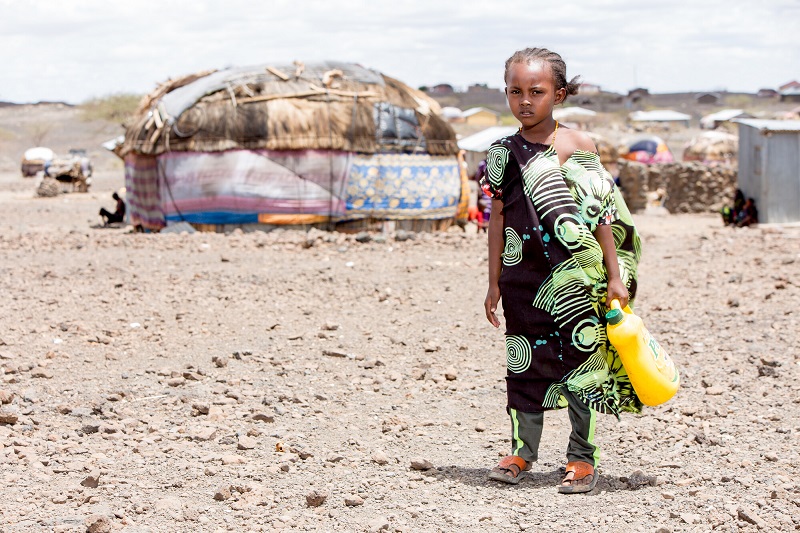
Kame, 5, begins the journey to draw water from a well several miles from her house. The area where she lives in Marsabit County, Kenya, is experiencing a prolonged drought.
Whispering winds pierce the air of a small community in Kenya’s Marsabit County. The terrain is flat and desolate: nothing for miles but mud huts, dried-up shrubs and the occasional passerby. As the wind picks up, 5-year-old Kame runs for shelter to the small stick- and grass-thatched structure where she lives with her family.
Most of the families living in this arid region of northern Kenya are nomadic pastoralists. Kame’s mother, Arbe, 35, is the family’s only breadwinner, caring for her paralyzed husband, her mother-in-law and her four children. The burden is great, especially in light of the area’s prolonged drought. It hasn’t rained here since December 2020, not even once.
“My five camels and 12 goats are supposed to be our lifeline — feeding us, paying for my children’s education and my husband’s medical expenses — but I don’t see them surviving this,” says Arbe, staring into the horizon.
Just then, Kame runs towards her mother, visibly fatigued from the hot sun. “Can Kabale make some porridge for me?” she asks, referring to her 16-year-old sister. Arbe shakes her head, saying that she will prepare the porridge herself.
The little girl dashes off to her grandmother, crying with hunger. “You said you’d make it in the morning! Now it’s afternoon, and you haven’t done it yet!”
East Africa drought: 2021
When the seasonal rains failed in late 2020, a severe drought overtook the arid and semi-arid regions of Kenya, affecting more than 4 million people. Marsabit County is one of the hardest hit areas. Thousands of children are now food insecure and in dire need of treatment for severe malnutrition.
A drought doesn’t have the sudden, shattering impact of other emergencies. Victims of earthquakes or flash floods barely have time to blink before they’ve lost possessions or loved ones in the disaster. In a drought, the trajectory of loss is slow.
First, the rains don’t come. In rural communities, residents make the necessary adjustments: They travel farther to get water, often pulling children out of school to help with the time-consuming search for pasture. Next, crops — the maize and millet people depend on for sustenance — begin to die, and families must sell whatever they have to buy food. Scarcity drives prices out of reach, and as competition for resources grows more intense, violence increases. By the time the livestock begin to starve, humans are not far behind.
People in East Africa are not strangers to these hardships. Between 2011 and 2012, a prolonged drought plunged Kenya, Ethiopia, Somalia and Djibouti into the worst food security crisis the Horn of Africa had seen in 60 years. This is the pattern: Every four or five years, a La Niña weather cycle, wrought by manmade climate change, brings excessively dry conditions to the region, causing widespread food and water shortages. Another severe drought occurred between 2016 and 2017, and now, the drought of 2021 is right on schedule.
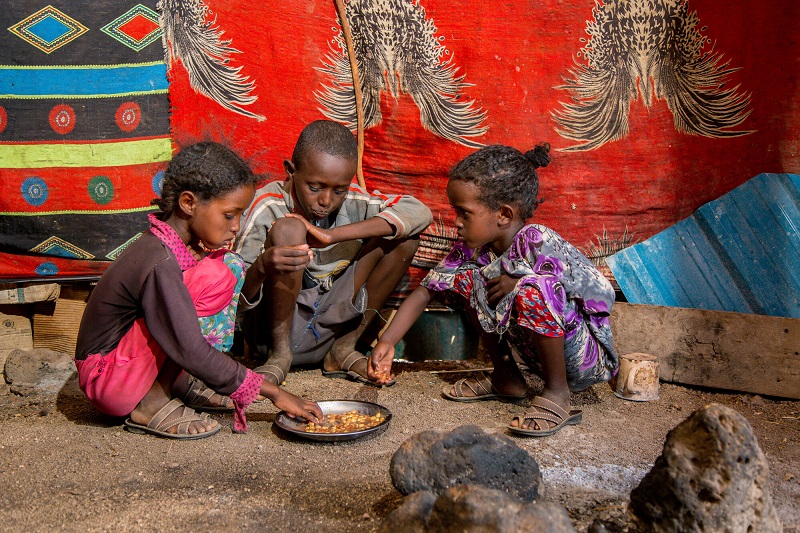
Tune (far left) and her siblings eat a meal of leftover maize and beans at home in Marsabit County, Kenya. “There is never enough food for me and my siblings,” the 8-year-old says.
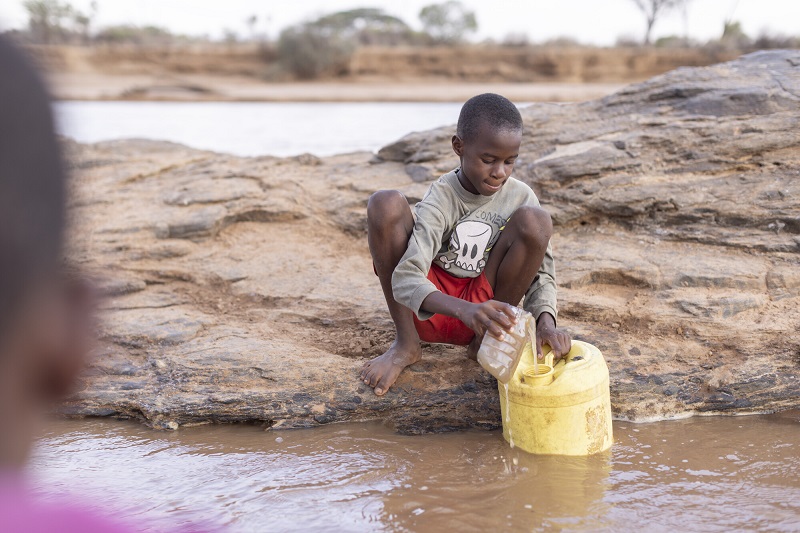
Clinton, 12, gets his water from a dirty river in Samburu County, Kenya.
But this time, the emergency is compounded by two others: the worst swarm of desert locusts the region has seen in half a century, and the COVID-19 crisis.
“This is one of the worst droughts I have ever experienced,” says Suka, a 29-year-old mother of six. “And I was born here. We cannot even afford one meal a day.”
She is especially worried about her 1-month-old twins, Adano and Ado, who are at risk of malnutrition. Feeding them is already a problem because Suka can’t produce enough milk for both – nor can she afford to buy it. For her older children, like Sabdio, 8, learning has become nearly impossible.
“If they eat at night but have no breakfast, they don’t want to go to school,” Suka says. “They missed school for three days every week last term. I cannot force them to go to school when they are hungry.”
“Sometimes I am too weak to go,” Sabdio chimes in. “During the rainy season, I would carry lunch to school, but now this is not possible at all. We don’t have enough to spare.”

Suka, 29, holds her 1-month-old twins, Adano and Ado, who are at risk of malnutrition because of the drought.
For still other children, school is not an option because they are too busy searching for water. Most natural freshwater sources in Marsabit have dried up, putting immense pressure on the few available boreholes and dwindling water pans.
“We leave at dawn before the sun is too hot and return hours later with two or three jerrycans of water on our donkey,” says Tune, 8. “Now, the donkey is too weak. He will only carry two jerrycans at a time, and he has to rest along the way.”
Sabdio remembers when the water points had plenty of clean water for drinking and household use. “Now the water is dirty, but we have no option but to use it,” she says.
“I used to wake up, fetch water, then go to school. But not anymore,” Sabdio adds. “I feel sad that I cannot go to school.”
Help children in Kenya
When drought pervaded East Africa in 2011, the incredible generosity of ChildFund’s supporters allowed our local partner organizations in Kenya and Ethiopia to quickly swing into action, supporting affected kids and families with nutritious food, clean water and health care. Again in 2017, we were there to help them survive. Now, in 2021, the situation is more dire than ever – and children again look to us for support.

Students eat a meal at a ChildFund-supported school in Kenya during the drought of 2017.
ChildFund’s response to drought in East Africa is multifaceted. Not only do we work with local governments and other nonprofits to deliver clean water and food items like rice, beans and cooking oil directly to families, but we also work with schools to provide free lunches to students. Having a free meal at school every day allows more children to stay healthy and continue learning, even during a drought.
Health care is another lifesaving measure. ChildFund holds clinics and growth monitoring sessions in communities to identify children and family members who are suffering from malnutrition and other illnesses related to hunger or drinking dirty water. Then we make sure they get the treatment they need.
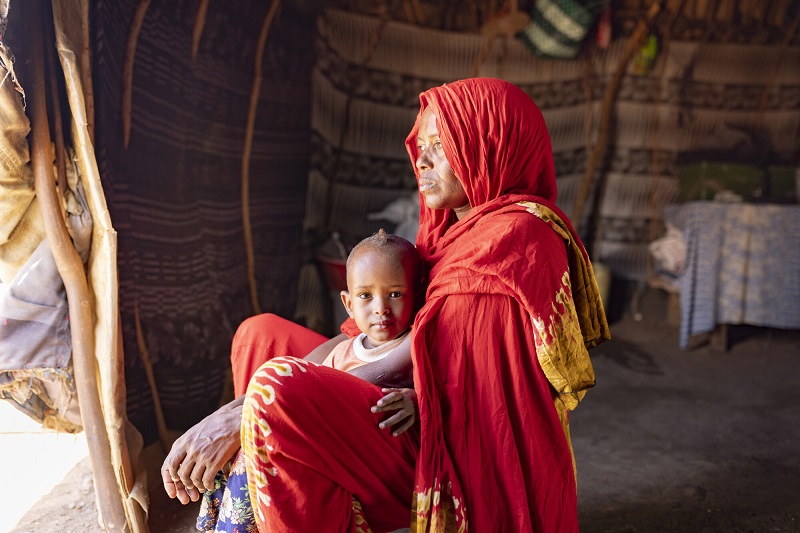
Kabale, 3, was suffering from severe acute malnutrition when ChildFund began delivering food relief to her family during the drought in Marsabit County, Kenya. "Many times, we stayed hungry the whole day and night because we didn't have food to cook," says her mom, Teso. "The supplementary food we received helped Kabale gain weight, and the cash transfer helped us buy the milk and food she needs. We're so thankful."
Finally, because drought in East Africa is predictable to an extent, prevention measures are critically important to mitigate its effects. With your support, ChildFund innovates sustainable solutions to problems in water-scarce areas – helping families plant drought-resistant crops, for instance, or building solar-powered water pumps that allow communities to farm even in dry conditions. We also support families with ongoing livelihood opportunities that bolster their financial resilience to disasters of all kinds.
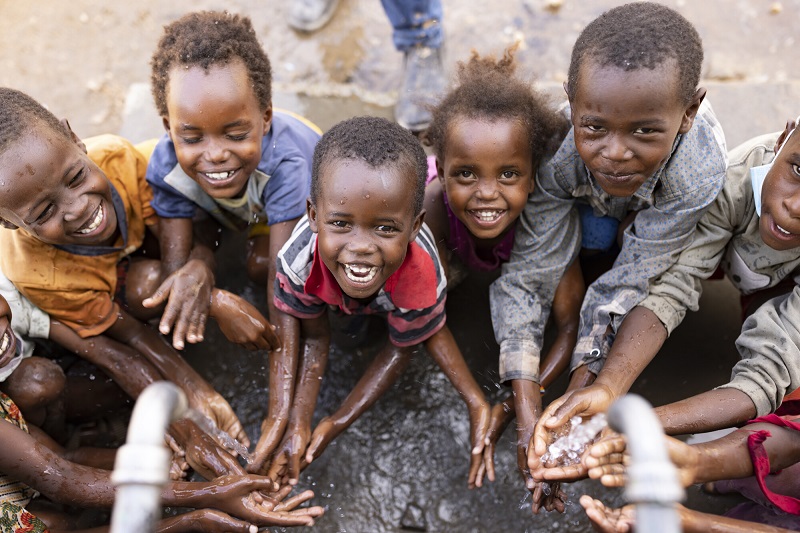
ChildFund installed this well in Samburu County, Kenya, in August 2021 as part of our emergency drought response. It serves 310 households with clean drinking water. Before, families used to have to walk 30 minutes to get their water from a dirty river, but even this source dried up during the drought. The new well was built just in time.
Kids like Kame, Sabdio and Tune remain hopeful that things will get better – that the wells will one day be full of water again, their plates full of food, their families less exhausted and terrified. Until then, they’ll be praying for rain.
“When it rains, we have plenty of food, and we do not miss school at all,” Sabdio says.
Your support can make a lifesaving difference. Help us bring food, clean water, medicine and more to children in Kenya today.
Loading...



